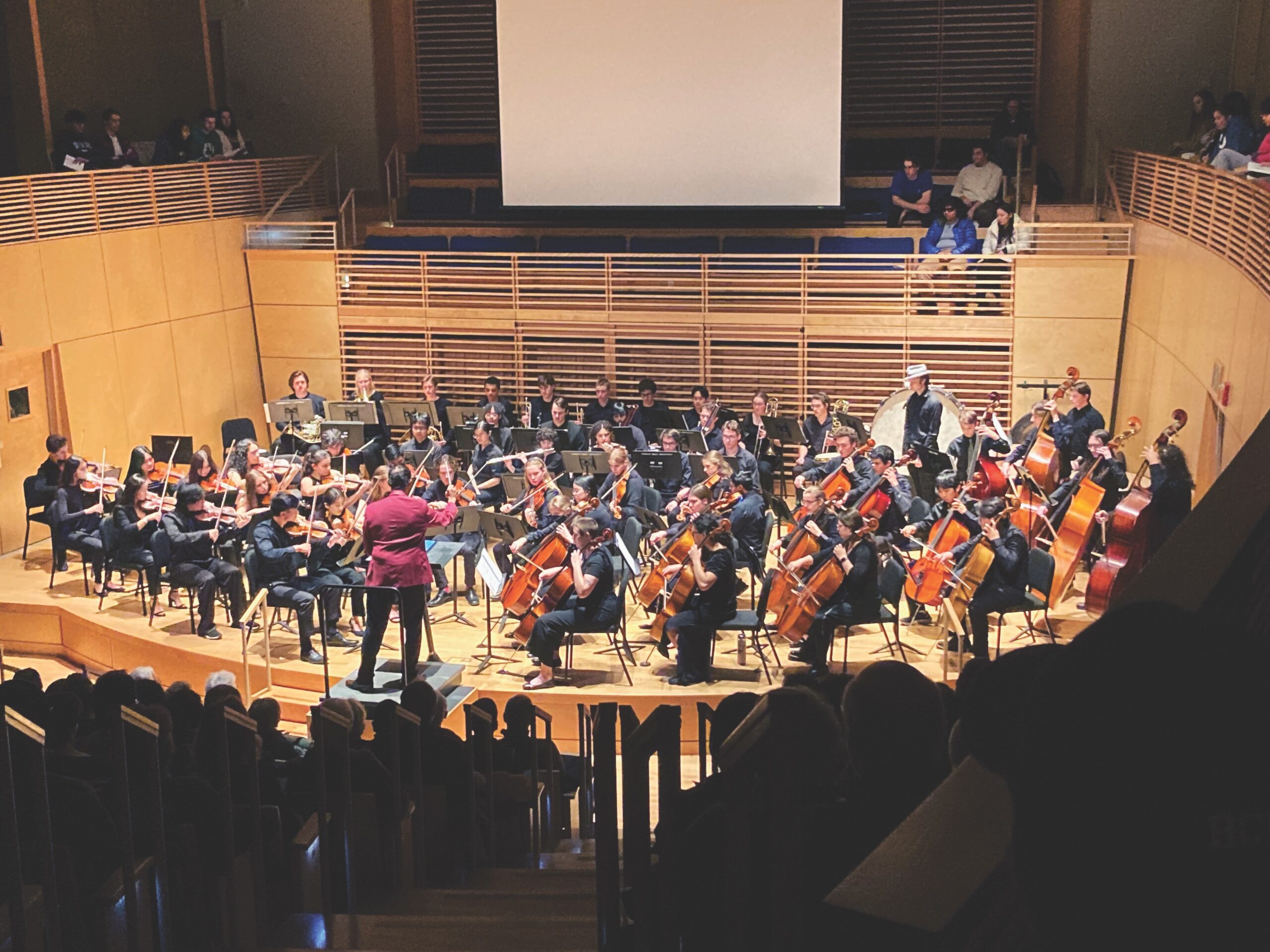A concert of celebration: Bowdoin Symphony Orchestra presents its annual fall performance
November 17, 2023
 Cora Dow
Cora DowMusic from Sergei Rachmaninoff’s second symphony and José Elizondo’s “Estampas Mexicanas,” performed by the Bowdoin Symphony Orchestra in their annual fall concert, filled Studzinski Recital Hall on Sunday afternoon and Wednesday evening.
Before the music began, Beckwith Artist-in-Residence and Director of the Bowdoin Orchestra George Lopez presented the audience with a video of his search for a statue of Rachmaninoff, a famed Russian composer of the early 20th century, in Knoxville, Tenn., where he visited last month for a performance. Student performers shared Lopez’s passion for Rachmaninoff’s second symphony.
“[Rachmaninoff’s second symphony] was one of the pieces that made me fall in love with music,” bassoonist Arjuna Sivapala ’25 said.
Lopez said he searches for pieces that the symphony students will be challenged by but also enjoy and be able to refine in time for the performance. He looked for a piece to honor Rachmaninoff at this fall’s performance because this year marks the 150th anniversary of the composer’s birth.
The second piece played at the concert was more contemporary. Lopez chose a piece by Elizondo, a dual engineer-composer at the Massachusetts Institute of Technology who himself was in attendance at Sunday afternoon’s performance. Lopez thought the Rachmaninoff piece complemented the more playful nature of Elizondo’s piece, “Estampas Mexicanas.”
“It just worked out very perfectly. [Elizondo’s piece] acts as a nice foil to the serious darkness of Rachmaninoff’s music,” Lopez said.
Elizondo wrote “Estampas Mexicanas” in a composition class his final year of college. The piece was originally just a homework assignment.
“I had no aspirations for [the piece],” Elizondo said. “I feel like it’s such a blessing, because it was never intended to have such a reach.”
For the original assignment, Elizondo’s professor encouraged him to explore a key part of his identity. Elizondo decided to focus on his Mexican heritage. “Estampas Mexicanas” is a celebration of Mexican culture and vitality, which Elizondo captured by dedicating each movement to three pillars of Mexican classical music: Carlos Chávez, Silvestre Revueltas and Manuel Ponce.
To honor the composer, the orchestra presented Elizondo’s piece with an improvisational flair. At the end of the second movement, the music dropped out and the orchestra began whistling together to simulate a bird-like coo. Elizondo relished in the surprise.
“They took [Estampas Mexicanas], personalized it and made it even more magical,” he said.
Seeing his music performed live presents a trade-off to Elizondo: He described the vulnerability of sharing his music with others but added that it excites him to see the orchestra create something beautiful with his music.
“I had a mixture of nerves and excitement,” Elizondo said. “But … they made it work so beautifully, and it was clear that they were also having fun.”
He left impressed with Bowdoin’s Symphony Orchestra.
“What has been achieved by this orchestra program is truly remarkable to see,” Elizondo said.
The concert was a celebration of the composers, the music and the organization itself. The symphony is now the largest it has been since the onset of the Covid-19 pandemic, with almost 70 musicians.
Lopez was proud to announce there will be three performances by the group this year instead of the traditional two because of the increased size and improved talent. The second concert, which will be near the middle of next semester, will feature less traditional music—known in classical music as a “Pops concert.” For the first time, there will be a third concert in May where the orchestra performs with the chamber choir.
“[The May performance] is going to be a big extravaganza for the music department,” Lopez said. “We have not done a combined concert for a very long time.”
Lopez hopes the concert fosters a sense of joy and connection in the audience. He thinks music has the ability to heal and is especially helpful in times of great division.
“The way the arts create connection and community … is needed more than ever. We all feel it. We all want more of it,” Lopez said.

Comments
Before submitting a comment, please review our comment policy. Some key points from the policy: